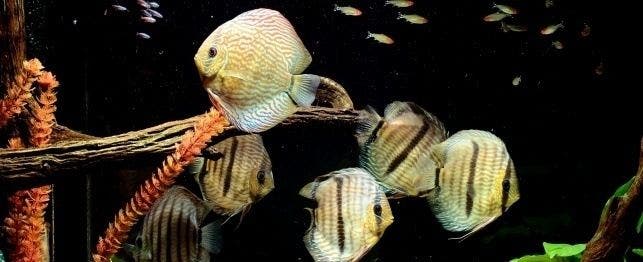
Choosing a Discus
Of the hundreds of cichlid species kept in freshwater aquariums, discus (Symphysodon spp.) are among the most beautiful. This magnificent fish is also a delicate one, and requires more time, patience, care and labor than the average tropical fish. These fish are not for beginning hobbyists. You must have a good working knowledge of filtration and water chemistry, and enough time to devote attention to your fish on a daily basis. Natives to the Amazon river tributaries, captive fish require daily observation, careful and frequent feedings, and pristine water conditions to thrive. Discus will do best in the hands of the dedicated aquarist. However, their beauty will eventually lure many hobbyists to try keeping a few discus. Before you start, read on.
Appearance and Behavior
Discus derive their common name from their appearance, which is disc-like and flattened. Easily seen from the side, they all but disappear when viewed head-on from the front. Their appearance is striking because of their beautiful colors and markings, ranging from red to iridescent turquoise. Not many aquarium stores will carry more than one or two color varieties. True discus hobbyists often buy their fish from private individuals or obtain fish of striking color from their own endeavors in breeding. The colors of the captive-bred discus are far more vivid than those of native species.
Unlike their more pugnacious cichlid cousins, discus are a peaceful schooling fish by nature. Tank conditions often produce a bully, but they usually will live peacefully with one another. Their native habitat consists mostly of tree roots seated in a sand bottom, and the fish will use these roots as cover and protection from the light. They are a shy fish and easily startled but will quickly come to recognize their keepers and respond to a familiar face.
Once established in a tank, keepers recognize their fish’s normal pattern of swimming, eating and foraging. Any variation in a discus’ appetite, activity or appearance must be considered a sign of illness. Discus are delicate fish, unable to tolerate polluted water, changes in pH , temperature and water chemistry. Any such stress will quickly be reflected in your fish’s behavior and appearance.
Feeding and Tank Requirements
Caring for discus is certainly a topic that’s open to discussion. Ask 10 different hobbyists about how they have their tanks set up for discus and you’ll likely get 10 different answers. In general it is safe to say that discus require ultra pure water conditions. You will need to have a water source analysis done so you know exactly what’s in the water before you fill the tank. Depending on the results of the water analysis, you may require special equipment/procedures to detoxify the water, such as a de-ionizer or reverse osmosis. Discus require soft, acid water and temperatures kept considerably higher than most tropical fish. Water temperature should be maintained between 86 to 88 degrees Fahrenheit. In times of stress or disease, it may be necessary to raise the tank temperature as high as 92 F. You should make sure you have a heater in your tank able to hold these high temperatures without fluctuation.
Filtration is essential as discus will not tolerate the usual tank pollutants that other tropicals will. Ammonia, a natural fish waste, will kill discus quickly. Oftentimes, a variety of filters plus daily water changes are needed to keep the tank water clean. It is imperative that any excess food and fish waste be vacuumed from the tank to prevent the water from fouling.
Discus also have a larger space requirement than do other fish. A general guideline is to allow 10 gallons of water per adult fish (about 5 to 6 inches). Discus need a lot of room in the tank and are easily stressed if overcrowded. You should plan on having a tank of 75 gallons or more for best results.
Discus do have hearty appetites and healthy fish will accept a variety of foods. Do remember that live food and certain dried foods such as tubifex worms have the ability to introduce parasites into the tank. Choose your foods wisely and feed 3 to 5 times a day. Do not feed so much food that it cannot be consumed. Left over food fouls the water. Flakes, beef heart, and frozen foods formulated specifically for discus are all possible choices. Feed a variety for best results.
Special Concerns
No discussion about discus would be complete without mentioning that these fish are very susceptible to parasites. Intestinal worms, gill flukes, fungi, bacteria are common illnesses typically brought on by stress and poor husbandry practices. Because of this, it is probably best not to mix other fish in with your discus until you a completely familiar with proper tank management.
Like most cichlids, discus will disturb aquarium plants and your choices will be somewhat limited. Plants native to the Amazon will have the best chance of surviving the warmer tank temperatures.
Discus are truly an investment. A medium fish of 2 to 3 inches with good color could easily cost $100.00.